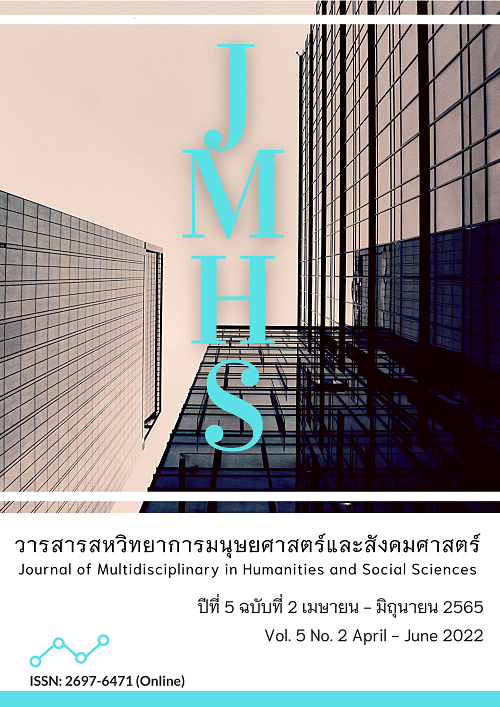The Balancing of Controlling Faculty According to the Four Primary Elements in Buddhism
Main Article Content
Abstract
The article on balancing the controlling faculty according to the four Primary elements in Buddhism has 3 objectives: 1) to study the controlling faculty 2) to study the four primary elements 3) to balance the controlling faculty according to the four primary elements in Buddhism. The analysis revealed that the controlling faculty are the determination of the five steadfast minds, namely: 1) Saddhindriya is the determination of one's devotion to what should be admired, and 2) Viriyindriya is the determination of perseverance. 3) Satindriya is the determination of being able to remember or being mindful; 4) Samadhindriya, the determination of one's actions to achieve concentration; 5) Pannindriya, the firming of wisdom or Enlightenment: Formation, aggregates, or body masses arise from things that are interconnected elements of the four elements, which are the earth element, the water element, the wind element, and the fire element, also known as the Mahabhutarupa. Balancing the controlling faculty according to the four Primary elements in Buddhism s according to the 4 elements by defining knowledge of the Sabhavadhamma, for example determining the knowledge of the formation that It's just a pile of pictures It is impermanent, suffering, not self, which leads to Vipassana-bhavana without being too strict or too low in order to achieve a middle path in practice, is liberated because of not holding on to it, do the tasks that should be done, attain Nibbana.
Article Details

This work is licensed under a Creative Commons Attribution-NonCommercial-NoDerivatives 4.0 International License.
Views and opinions appearing in the Journal it is the responsibility of the author of the article, and does not constitute the view and responsibility of the editorial team.
References
พระเทพปัญญาเมธี (ทองอยู่ ญาณวิสุทฺโธ). (2558). สารัตถธรรม. กรุงเทพฯ: โรงพิมพ์มหาจุฬาลงกรณราชวิทยาลัย.
พระพรหมคุณาภรณ์ (ป.อ. ปยุตฺโต). (2552). พุทธธรรม ฉบับปรับปรุงและขยายความ. (พิมพ์ครั้งที่ 11). กรุงเทพฯ: โรงพิมพ์มหาจุฬาลงกรณราชวิทยาลัย.
พระพรหมคุณาภรณ์ (ป.อ. ปยุตฺโต). (2556). พจนานุกรรมพุทธศาสตร์ ฉบับประมวลธรรม. (พิมพ์ครั้งที่ 24). กรุงเทพฯ: ธรรมสภา.
พระมานะ พุฒจันทร์ และ วิโรจน์ คุ้มครอง. (2565). อสุภกัมมัฏฐานอันเป็นบาทฐานในการปฏิบัติวิปัสสนาภาวนา. วารสารสหวิทยาการมนุษยศาสตร์และสังคมศาสตร์, 5(1), 327-338.
พระโสภณมหาเถระ (มหาสีสยาดอ). (2553). วิปัสสนาชุนี หลักการปฏิบัติวิปัสสนา. (จำรูญ ธรรมดา, แปล). กรุงเทพฯ: ประยูรสาสน์ไทยการพิมพ์.
พระโสภณมหาเถระ (มหาสีสยาดอ). (2554). นิพพานกถา. (พระคันธสารภิวงศ์, แปล). นครปฐม: ประยูรสาส์นไทยการพิมพ์.
พระสมชาย บัวแก้ว, พระมหาบุญศรี วงค์แก้ว และ สุเชาวน์ พลอยชุม. (2564). อภิสมาจาร: กระบวนการพัฒนาบุคลิกภาพตามแนวพระพุทธศาสนา. วารสารศิลปการจัดการ, 5(3), 895-907.
มหาจุฬาลงกรณราชวิทยาลัย. (2539). พระไตรปิฎกภาษาไทยฉบับมหาจุฬาลงกรณราชวิทยาลัย. กรุงเทพฯ: โรงพิมพ์มหาจุฬาลงกรณราชวิทยาลัย
วิริยะ สว่างโชติ. (2550). คุณภาพชีวิตและการส่งเสริม. สืบค้นเมื่อ 20 กุมภาพันธ์ 2565, จาก http://www.thaingo.org/writer/view.php?id=410.
Chanthathong, S. (2021). The Significance of the Right View (Sammaditthi) in Theravada Buddhism. Journal of International Buddhist Studies, 12(1), 61-70.
Damnoen, P. S., Siri, P., Supattho, P. S., & Kaewwilai, K. (2021). The Development of Student Characteristics in According to the Nawaluk Framework of the Buddhist integration of Buddhapanya Sri Thawarawadee Buddhist College. Asia Pacific Journal of Religions and Cultures, 5(2), 126–135.
Tan, C. C., & Damnoen, P. S. (2020). Buddhist Noble Eightfold Path Approach in the Study of Consumer and Organizational Behaviors. Journal of MCU Peace Studies, 8(1), 1–20.
World Health Organization. (2002). Active ageing: A Policy Framework. Geneva: World Health Organization.


